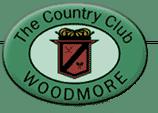By Jeffrey A. Rendall, Photos by Jeff Janas
MITCHELLVILLE, MD – Remember picking a college? You probably thought it was the most important choice you'd ever make, except for maybe choosing a mate. |
|
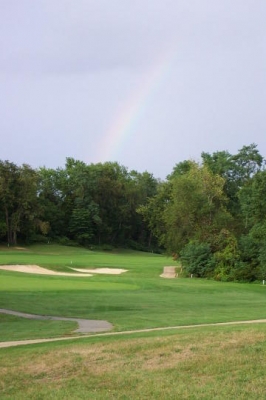 |
| A rainbow presides over the dogleg on the 7th hole. |
And if you're like most people, you went through a lengthy selections process, pouring over numerous brochures, talking with dozens of 'counselors' and finally visiting the schools you thought would fit the best. Invariably, when visiting the campuses, you thought it was either the greatest place on earth, or not quite what you'd envisioned.
For many, the right match is the difference between the 'big campus' feeling — with tens of thousands of students, a huge football stadium and dorms the size of a Las Vegas hotel – and a 'small campus' feeling, with intimate class sizes and an enrollment cap designed to afford you the chance to sip coffee on the college green without being trampled by the masses.
Country clubs are often the same way. You'll see your large-scale clubs with eons of history, clubhouses the size of small castles and parking lots that would make a shopping mall blush. Then there are some clubs that epitomize the meaning of 'country,' where the staff knows your name, the décor is earthy but attractive and you just seem to feel at 'home' there — kind of like at a small college.
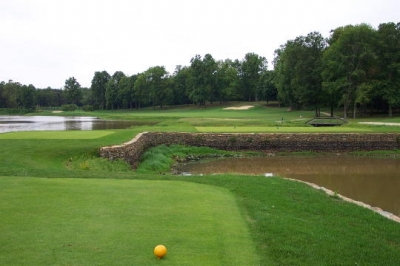 |
| Looking towards safety on the 15th hole. |
That's the feeling you'll get at the Country Club at Woodmore in Mitchellville, Maryland. The club has a long and storied history, yet still feels like the 'course next door,' devoid of pomp and pretension you'll notice at some other places.
"If I had to name the difference between us and some other clubs," commented Woodmore's Head Golf Professional Dave Long, "it's that ours has that 'small campus' feel to it. I've been to most of the other big name 'inside the beltway' clubs, and they're certainly spectacular in their own right, but at ours you just seem to get that close-knit community feeling. That's the difference in my mind."
Probably in a lot of other people's minds, too. The Country Club at Woodmore was originally called Prince Georges Golf and Country Club (it was Beaver Dam Golf and Country Club until 1941), being founded in 1923. More than just the name changed, as the original Donald Ross designed golf course (located on Landover Road) was purchased by the Maryland National Capitol Park and Planning Commission in 1979, mandating the club move to its current location in Mitchellville (near the US Air Arena).
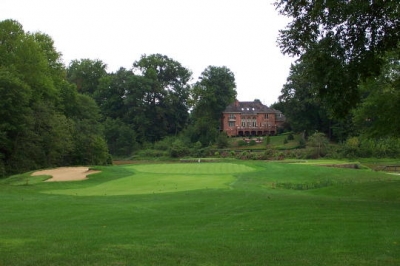 |
| The 230 yard, par three 14th is long and difficult. |
Arnold Palmer and design partner Ed Seay (with construction supervised by fellow course architect Algie Pulley) designed the 'new' course, which opened for play in 1981. Hardly missing a beat in quality from the old course, the current layout has hosted many championship events, the most recent being the 2002 US Senior Open Qualifier. It's a 'big campus' course with a 'small campus' feeling.
All this, and Woodmore's still not well known in Washington circles. Some might label it a 'best kept secret,' but that's an over-used cliché, and probably not even true. The secret may be 'kept' from the greater metro area, but the members don't seem to mind.
Ed Seay said Arnold Palmer was very impressed with the course when they built it: "Arnold, he was intrigued about the capability of the golf course. Because you could put some big time boys out there and set it up, with its capability, and it would take 'em downtown — they'd have to play a pretty good game to do well there. But he was also concerned that if it wasn't set up right, it'd play too difficult for the average club member."
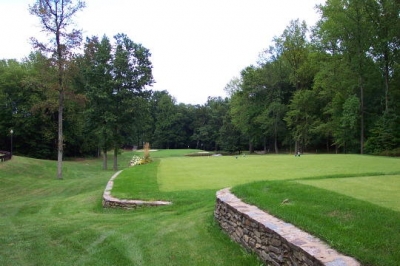 |
| Stone walls define the tee boxes on the picturesque par three 5th hole. |
"That's not to say he wasn't pleased. That's a tremendously solid golf course, where no two holes are alike. There's such undulation in the ground that it was possible to design a layout with a lot of movement. Every hole plays different, and we're really proud of that," Seay said.
Dave Long agrees with Seay's assessment: "On the whole golf course, there're maybe one or two straight holes. Most every hole has a dogleg, either left or right, and it really forces you to pick your spots to set up the next shot. It's generous off the tee, but the nature of the land, along with the mature trees forces you to be precise to score well here."
That's very true, and the difficulties are subtle. Many times, especially on the back nine, you'll find trees will turn what would seem like a great drive into one that's put you in trouble. Long says, "the course, from the back tees, plays almost 7100 yards, but despite that, it's not the type of layout where you can hit driver on every tee. It forces you to think about the correct sides of fairways and greens to play into, and once you're on the green, the slopes and speed of the greens will challenge your putting game, too."
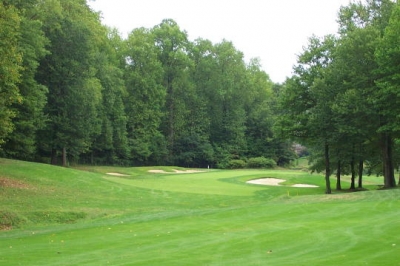 |
| Thread the needle to reach the 13th green. |
In that sense, it reminded me a bit of Harbour Town Golf Links on Hilton Head Island (sans the railroad ties, lighthouse, Spanish moss and alligators). What appears benign can be lethal. You'll become friendly with the arboretum that is the Country Club at Woodmore, but it's a beautiful journey.
Long points out the course is really only 'grueling' from the back tees. "We have a large representation of seniors and ladies at our club, and from the forward sets of tees, the course is really very playable. Almost all the greens are accessible to a run-up shot, and most of them are pretty large. Most people prefer a putt to a chip, so the big targets probably make people happy."
Another thing about Woodmore is its recent upgrades and improvements. The clubhouse was completely remodeled, and now it's a place where members will feel comfortable entertaining guests, according to Long. The dining facilities were expanded, as were the locker rooms. And the golf course also received some work.
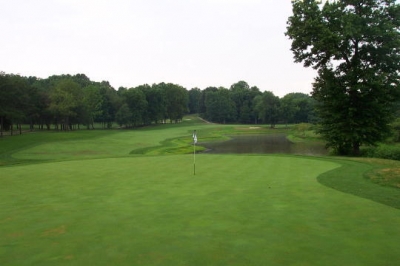 |
| The view from the 18th green... beauty and challenge defined. |
Tom Clark of Ault, Clark and Associates handled some of the redesign work, including rebuilding a few of the greens and reworking some of the holes to improve sight lines and aesthetics, such as the fifth hole, a 193 yard par three over a stream with a pond to the right of the green.
Clark says Woodmore's got a lot of potential: "It's one of those hidden gems in Maryland. It's got a great diversity of holes, and a lot of the work done to the course over the past decade has really improved the layout. On the fifth hole we added some rock walls around the tees, increased the size of the pond near the green, and changed the slopes in the green. I think the hole really improved."
Another enhanced hole is number three, a 417 yard, downhill dogleg right. This hole's a great example of a Woodmore's need for proper placement off the tee, as any drive not making it around the corner may find you blocked by trees for the approach shot. Compounding the difficulty is a sizeable pond that sits front and left. Long says the pond used to be 'only' a stream, and the green's slopes were redone so it runs away from you. This hole is rated the fifth handicap hole, but a par on this hole feels like a birdie.
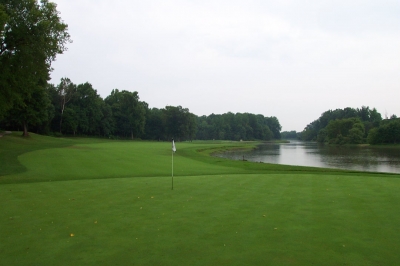 |
| Notice the water bordering the 15th green. |
The final hole on the outward nine sheds glimpses of Augusta National, a 204 yard par three over a lake to a green guarded by bunkers front and long. Ed Seay said, despite the hole's looks, they didn't intentionally try to make it look like the famous Georgia par three: "We don't incorporate stuff like that. I'll tell you who does though — God. We're smart enough to figure out and nestle a green, or a tee, or a fairway on a piece of ground that takes advantage of what's already there. Then it turns out and people say 'That looks like Augusta.' Keep in mind, we didn't do that, we just happened to get a golf hole in there. And there are several holes at Woodmore that give that type of impression."
It's hard to believe, but the back nine trumps the front on beauty and challenge. Every hole is memorable, though a 'murderer's row' of difficult holes begins with #13 and doesn't let up until the final putt. Thirteen is another placement par four, 412 yards in length and a slight dogleg left (and a stream runs the length of the hole). If your drive's not placed correctly, trees will definitely impede your shot into the green.
Fourteen is a 230 yard par three, with trouble abounding. Pretty to look at, though, with the lake in the background.
Fifteen is probably Woodmore's signature hole, as the tee boxes are placed in what seems like the middle of Lake Woodmore. An intimidating tee shot, and the second shot's no picnic either.
Eighteen's a spectacular closing hole, and you'd expect nothing less after playing the first seventeen. It's a 540 yard, dogleg left par five. You can't see the green from the tee (the trees block your view), and the lake guards the left side of the hole from the landing area to the putting surface. If played safely, it's not a difficult hole, but the risk reward qualities may tempt you to try and take a stroke back from a course that's certainly stolen some shots along the way.
It should be noted that Woodmore Country Club has the capacity to expand to 27 holes sometime in the future, though at current there are no plans to do so.
Summing up, Woodmore Country Club lies just outside the beltway, but being part of its peaceful community makes it feel like it's somewhere else. Perhaps even part of a college town – but make sure it's a small college atmosphere, because the 'big' theme just doesn't fit here.
Details:
The Country Club at Woodmore
12320 Pleasant Prospect
Mitchellville, MD 20721
Pro Shop telephone #: (301) 249-6100
FAX: (301) 390-2561
Website: www.ccwoodmore.com Course Designers: Arnold Palmer, Ed Seay (with Algie Pulley) Membership Information: Memberships are available. Contact Laura Mozer for information — (301) 249-6100, x: 110.
Additional Work: Tom Clark
Head Golf Professional: Mark Russo
Tees
Yardage/Slope
Gold
7089/137
Blue
6582/131
White
6195/126
Red
5534/117
| Related Links | Comments on this article? | |
|
Maryland National Golf Club Hollow Creek Golf Club Rocky Gap Resort PB Dye Golf Club in Ijamsville Whiskey Creek Golf Club |
E-mail Jeff Rendall, Editor: jrendall@golftheunitedstates.com |

